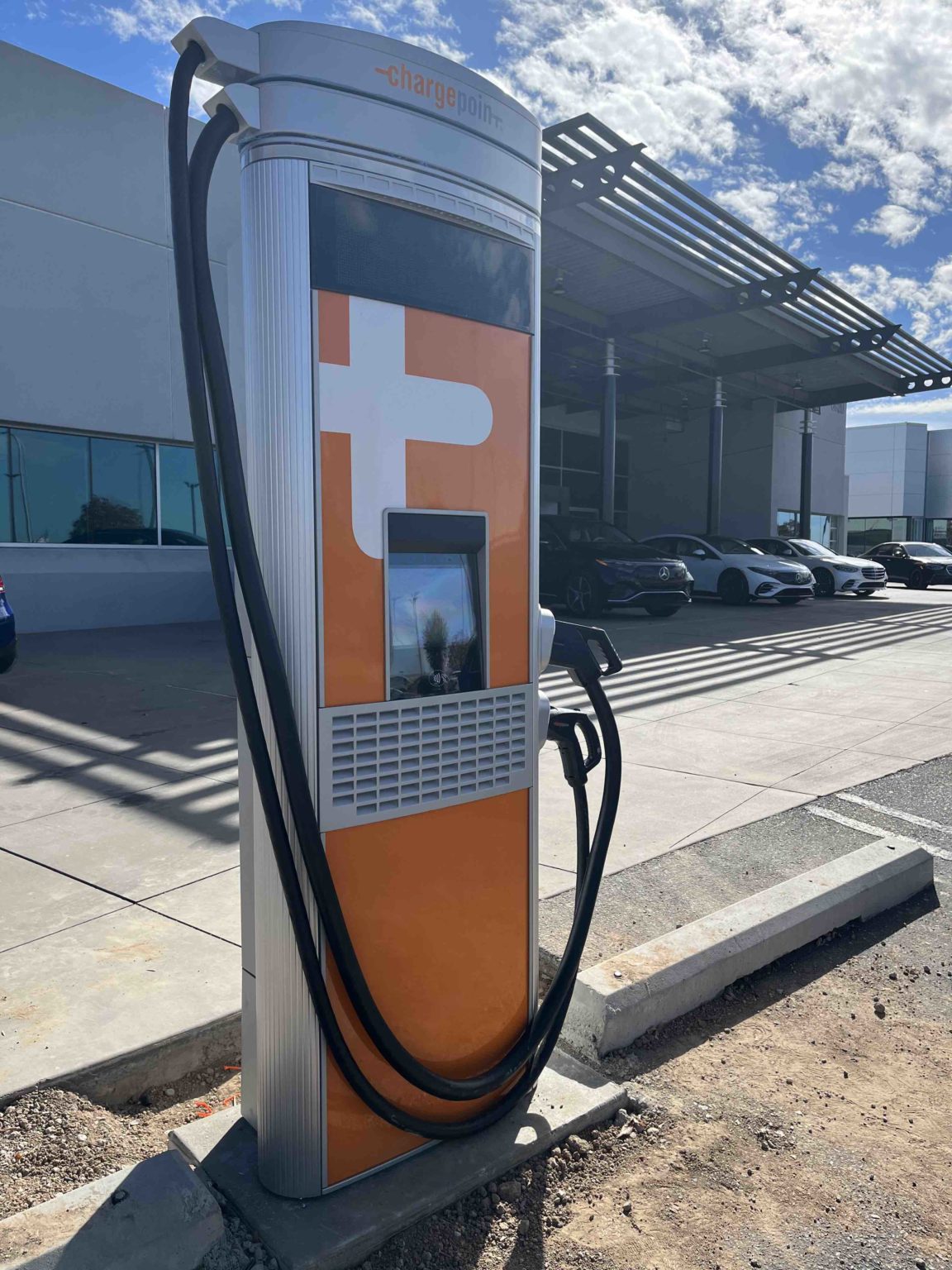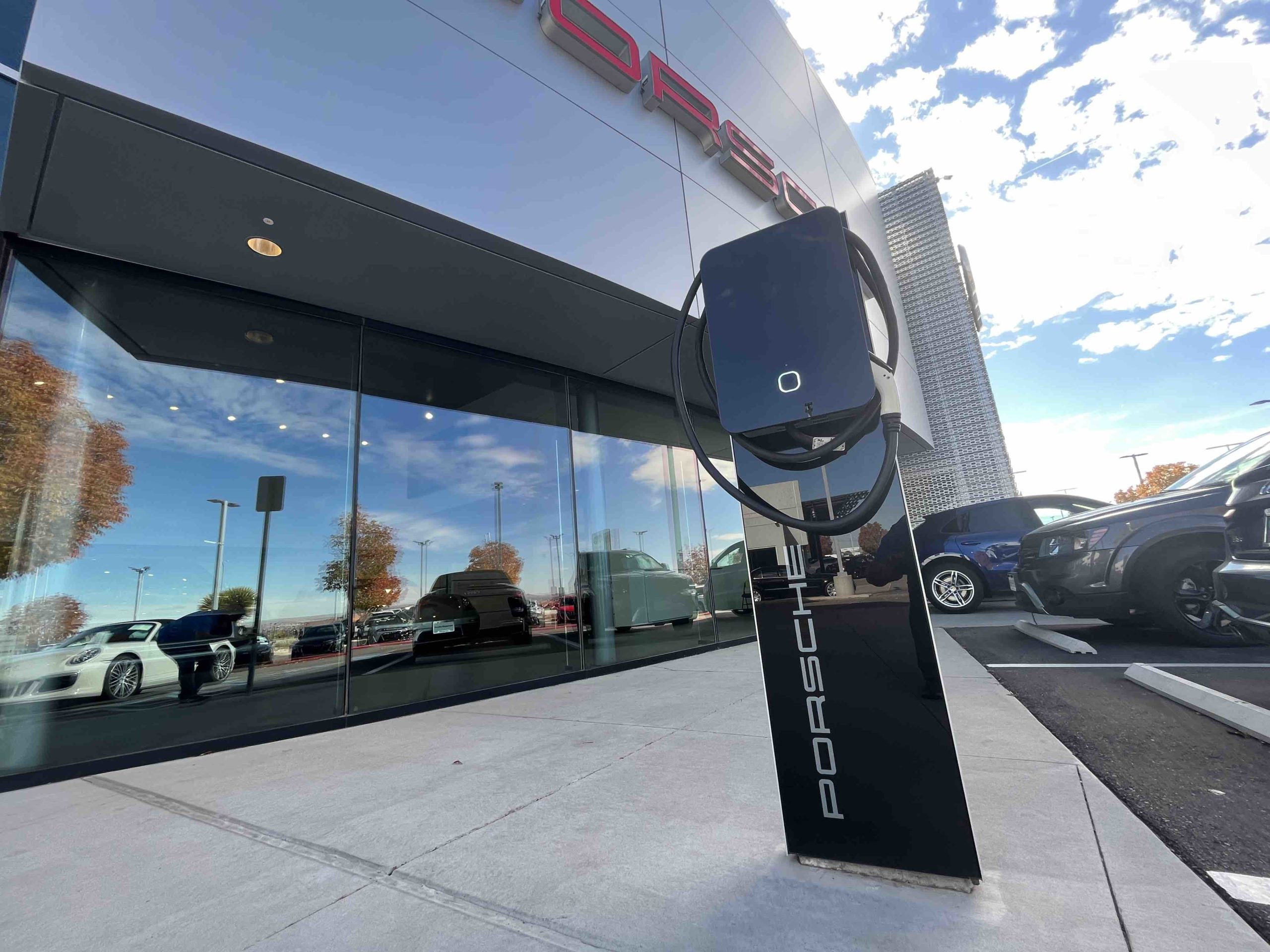A new ChargePoint Express 250 electric vehicle charging station was recently installed at the Mercedes-Benz of Albuquerque, 8920 Pan American Freeway, but it isn’t ready to plug into yet. Like other charging stations at car dealerships, it is mostly for customers and for charging electric vehicles being sold by the dealership.
“When they come in to get their vehicle serviced, we can plug it in for 10 minutes and top them off,” said a car salesman at the Porsche dealership next door.
One of the charging stations at that dealership is specific to Porsche owners, while another ChargePoint charger there can be used by a variety of electric vehicles. The salesman said many charging stations cannot be used by Teslas, but Tesla does provide converters so drivers can plug in at stations with different port types.
As different brands build out their own charging networks and new EVs and battery types come online, compatibility is becoming more of an issue. Both the Porsche and Tesla websites say they are offering their networks to more EVs in Europe and will continue expanding in North America.
According to a pamphlet on the ChargePoint website, “The Express 250 supports battery packs from 200V to 1000V, ensuring both legacy and future electric vehicles can always be charged.”
There are more ChargePoint stations in the far Northeast Heights than other types of charging stations, with several in close proximity to each other, and it can be expected that even more will go up in the future.
See the ChargeHub map below to find out where the stations are located and the type of ports they provide.
Expanding EV stations statewide
On June 16, 2022, ABQ Ride announced that five new electric buses were being added to its fleet. More recently, in an Oct. 26 statement on Sen. Martin Heinrich’s website, it says a total of $4,560,000 was awarded to five different school districts in New Mexico to purchase “clean” school buses.
“I am thrilled to welcome this first round of funding for the Clean School Bus Program. The clean energy and electrification investments that we secured in the Infrastructure Law and the Inflation Reduction Act are by far the most significant steps that Congress has taken to spur the widespread deployment of highly efficient, fully electric and climate pollution-free technologies,” Heinrich says in the statement.
“Modernizing the vehicles that transport New Mexico’s children to school — especially with clean and electric buses — will make our air cleaner and improve public health and create important energy and fuel savings for public school districts,” he continues. “Electrifying our homes, buildings and vehicles is one of the surest climate actions that we can take right now that will help secure a more equitable, healthier future for all our communities.”
With the addition of electric buses, government fleets and privately owned EVs, there is a growing demand to provide infrastructure along New Mexico’s highways for these vehicles to recharge.
The New Mexico Department of Transportation expects to receive around $38 million from the National Electric Vehicle Infrastructure Program over five years to install EV charging stations across the state.
According to a July 13, 2022, New Mexico EV Infrastructure Deployment Plan, eligible uses of NEVI funding include:
- Acquisition and installation of EV charging infrastructure and traffic control devices and signs.
- Operation and maintenance of EV charging infrastructure for up to five years.
- Data sharing about EV infrastructure to ensure the long-term success of equipment installed under the formula program.
- Development activities related to acquisition or installation.
- Mapping and analysis to evaluate locations for charging infrastructure.
Charging infrastructure created through NEVI funds must be open to the public or authorized commercial motor vehicle operators from more than one company. Chargers cannot be located more than one mile from an interstate off-ramp and be no more than 50 miles apart from each other. Each location must also include at least four 150 kilowatt (kW) direct current (DC) fast chargers with Combined Charging System (CCS) ports, capable of simultaneously charging four vehicles.
A survey completed by New Mexicans from 54 different zip codes provided feedback to New Mexico Department of Transportation on where EV charging stations should be located. According to the NMDOT report, “Most respondents want to prioritize EV chargers on corridors where there are gaps in the existing network, along interstates and roads with high traffic volumes, and in rural areas, whereas major cities, tourist destinations, and disadvantaged communities were seen as lower priority.”
The heat map below was generated by survey respondents clicking on different locations on a state map indicating the corridors they think should be prioritized for EV chargers.
Cost and speed of charging an EV
The free ChargePoint station in the parking lot of the North Domingo Baca Multigenerational Center is one of several EV charging stations near Interstate 25 and Paseo del Norte Boulevard. ChargeHub shows that the ChargePoint station at 5910 Holly Ave., in the Springhill Suites by Marriott parking lot, has two plugs that cost $1.32 an hour. Users can pay through the ChargeHub App, Network App or Network RFID.
A breakdown of prices comparing the difference between filling up on gas and fully charging an EV battery shows the cost savings of going electric to be negligible, depending on the make and model of the vehicle. The average cost of electricity in New Mexico is about 15 cents per kWh, so an EV with a battery capacity of 107 kWh will cost about $16 and provide a range of about 350 miles in some cars.
Vehicles with smaller battery capacities will provide a shorter range and will have to be recharged more frequently, and vehicles that have a greater range with a larger battery capacity will need to be recharged less frequently, but the cost of those vehicles tend to be more expensive.
To save the life of a battery, it is recommended to only recharge to about 80% of capacity when driving in the city but to fully recharge when going on long road trips. The type of chargers available on road trips will vary, and so will charge times.
An Express 100 DC fast charger provides 100 RPH and an Express 200 DC fast charging station provides 200 RPH. The fast chargers can provide enough juice to charge a battery to 80% capacity in about 30 minutes.
According to Tesla’s website, a Tesla Supercharger can provide up to 200 miles in 15 minutes, but those chargers can only be used on Teslas. Electric vehicle owners can also buy personal, at-home chargers or plug into a 220-volt electrical outlet. Home charging can take up to 12 hours or longer to get a battery to full capacity.



